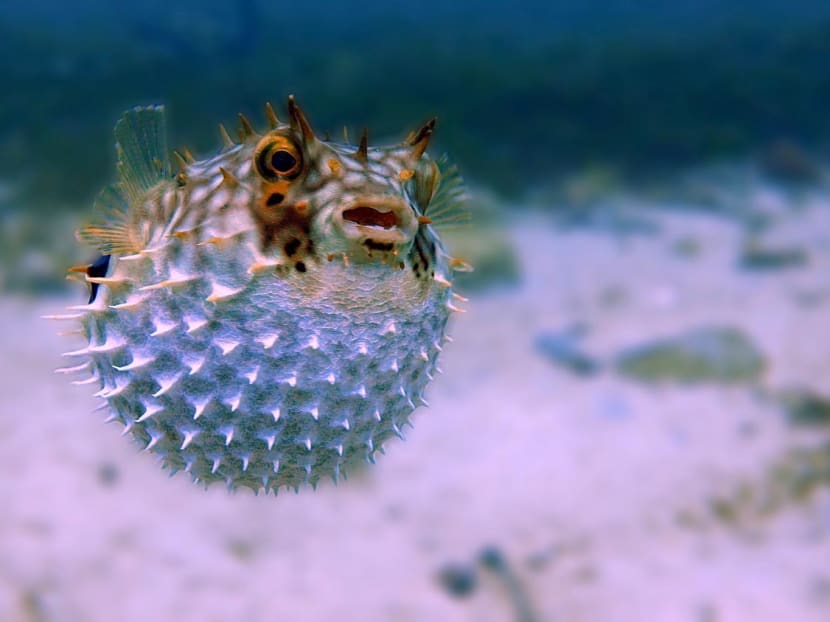Explainer: Why puffer fish can be deadly and how it can be consumed safely in Singapore
SINGAPORE — Last week, a couple in their 80s from Malaysia died after consuming puffer fish, in a grim reminder that the poisonous fish, regarded as a delicacy by some, must be prepared carefully by experts.

A couple died in Malaysia after consuming puffer fish (pictured) in March 2023.
- Puffer fish can be deadly, but there is growing appetite for the fish regarded by some as a delicacy
- One Japanese importer said he is seeing growing demand for the fish, also known as fugu, from Singaporeans
- This is despite the fish containing a lethal colourless and odourless toxin called tetrodotoxin
- Pufferfish is not limited to Japanese cuisine — Singapore's Orang Laut also catch, prepare and serve a puffer fish delicacy here
SINGAPORE — Last week, a couple in their 80s from Malaysia died after consuming puffer fish, in a grim reminder that the poisonous fish, regarded as a delicacy by some, must be prepared carefully by experts.
Puffer fish contains a lethal colourless and odourless toxin called tetrodotoxin. As little as 0.002g is enough to kill an adult, the Singapore Food Agency (SFA) states on its website.
Yet, despite the danger, Singaporeans are stomaching the thrill of tasting the highly prized delicacy, popularised in Japan where it is known as fugu.
And in Singapore, the Orang Laut — a Malay phrase used to describe an ethnic group of seafarers who live along the Strait of Singapore, peninsula Malaysia and the Indonesian Riau islands — still serve puffer fish at the dinner table each year in a long-standing tradition.
TODAY takes a closer look at the craving for puffer fish among some Singaporeans and how safe it is to consume this potentially deadly seafood.
WHERE IS PUFFER FISH SOURCED AND WHO EATS IT?
Puffer fish can be found in some Japanese and Chinese restaurants here and is often served raw. It is said to have a very mild flavour for seafood.
It does not come particularly cheap — a plate of puffer fish sashimi costs between S$28 and S$39, based on checks by TODAY at three Japanese restaurants.
Mr Yukihiro Furukawa, the president of fugu importer Fu, said that his company has been importing the fish into Singapore since January 2021. The puffer fish he supplies are both wild-caught and farmed.
Mr Furukawa, who is also the president of the International Fugu Association, added: “Orders for fugu products from Singapore have been gradually increasing since last September.”
His firm sent its largest shipment to Singapore the week before Chinese New Year that began on Jan 22 — 50 small cases of fugu weighing just 30kg in all.
He supplies fugu to 10 restaurants in Singapore and this number is set to increase during the upcoming puffer fish season.
Ms Linda Loke, director of food and beverage of Si Chuan Dou Hua Restaurants, told TODAY that she has also observed an increase in demand for puffer fish in Singapore in recent times.
Previously, fugu was imported here only a few times a year, but that has increased, especially in the lead-up to Chinese New Year this year, said Ms Loke, who is also a member of the International Fugu Association.
She added that each batch of puffer fish exported to Singapore has a certificate indicating the location and time that it is processed and to show that it has fulfilled SFA’s requirement.
However, puffer fish is not just limited to Japanese or Chinese cuisine.
In a dish known as lauk buntal masak kerabu, the Orang Laut serve up a peppery and spicy version of puffer fish cooked with chili, pepper, garlic, kangkong (water spinach) and lemongrass.
Mr Firdaus Sani, 34, founder of Orang Laut Singapore, said: “It’s a dish that defines our community.”
His family eats the dish about four to five times a year, spending hours to remove the poison from the fish.
And unlike the Japanese, Mr Sani’s family consumes some of the organs in the fish — the potentially poisonous liver included.
HOW IS PUFFER FISH PREPARED IN SINGAPORE?
Tetrodotoxin is typically concentrated in the ovaries, liver and intestines of puffer fish, a circular issued by SFA states.
Puffer fish accumulate the toxin as a defence mechanism from the food they eat. Therefore, farmed puffer fish subjected to a controlled tetrodotoxin-free diet are typically free from the toxin.
Whole, unprepared puffer fish cannot be imported here.
However, SFA has approved the export of certain farmed puffer fish parts, and puffer fish meat from both wild and farmed fish.
As for the Orang Laut in Singapore, their preparations start with sailing a boat from West Coast Park and setting fish traps, known as bubu, for about a week on the ocean bed.
After the traps are retrieved, Mr Firdaus’ mother and aunt spend between six and eight hours removing the poison from the fish using a labour-intensive method passed down over the generations.
He added that the skin would have been dried and made into drums traditionally.
“It’s tons of work to cook it. A medium puffer fish that weighs about 5kg can feed about 20 to 25 people.”
His family’s favourite puffer fish parts are the liver and gills. And as with most traditions, there are rules to follow when consuming puffer fish — no coffee or fruits with sap after eating this delicacy.
This culinary practice, though, appears to be a dying tradition, Mr Firdaus said, because the family is able to catch and prepare puffer fish only a handful of times a year.
With limited sources of fresh puffer fish beyond heading out to sea to catch their own, Mr Firdaus said that his family members who are hoping to learn the technique are uncertain if they will have enough experience to confidently prepare puffer fish safely.
FROM WHERE DO RESTAURANTS GET THEIR PUFFER FISH?
SFA told TODAY that all puffer fish must be supplied from SFA-accredited establishments with a health certificate issued from the authorities of the exporting country.
Currently, 19 establishments in Japan are approved to import farmed or sea-caught puffer fish into Singapore.
“SFA assessed that Japan has satisfactory regulatory controls to ensure that all puffer fish products are fit for human consumption,” the agency said.
These controls include having certified specialists preparing the puffer fish, proper food safety management systems and traceability systems.
HAVE THERE BEEN CASES OF PUFFER FISH POISONING IN SINGAPORE?
Although there has been no reported death from puffer fish poisoning in Singapore, news outlet AsiaOne reported that two chefs were poisoned non-fatally in 2007 after taste-testing a puffer fish they were to serve.
In response to queries, SFA said that it has not detected any tetrodotoxin in puffer fish imported here.
“Consuming puffer fish that have been caught in the wild or prepared by amateurs is the most common cause of tetrodotoxin poisoning,” it added.
“Consumers who choose to consume puffer fish should be aware of the potential food safety risks. Anyone who has consumed puffer fish and feels symptoms like tingling, numbness and any form of paralysis should seek medical attention immediately.”
The agency also said that consumers can refer to its Risk-at-a-glance article on its website for more information about puffer fish consumption. ADDITIONAL REPORTING BY WONG J-MIN








